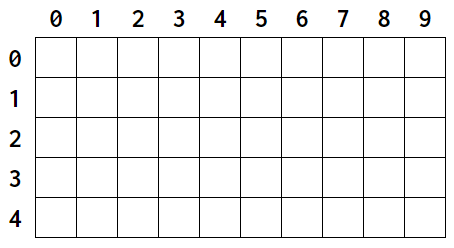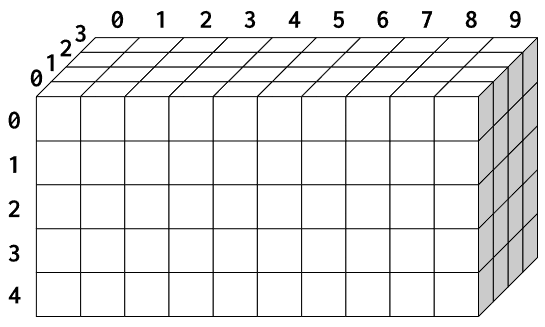자료구조 3. 배열
코드
- 모든 코드는 깃허브에서 확인하실 수 있습니다.
배열(array)
- 데이터를 연속적으로 저장하는 자료구조
index에value이 대응됨index는0부터 시작- 첫 번째 요소의 시작점과 배열의 시작점이 같기 때문
- 배열의 주소 = 첫 번째 요소의 주소 + 0
arr[3]처럼index를 통해value에 접근할 수 있음
- c언어
type arrayName[length] = { init };
2차원, 3차원 배열
2차원 배열
3차원 배열
c언어
2d array:
type arrayName[row][col] = { {}, {}, ... };3d array:
type arrayName[depth][row][col] = { { {}, {}, ...}, { {}, {}, ...}, ... };
메모리에는 1차원 배열처럼 일렬로 저장됨
- 주로 row-major 방향으로 저장
[i][j]=i * col(width) + j
- 주로 row-major 방향으로 저장
구조체
다양한 자료형을 모아놓은 구조
관리의 용이성을 위해 사용
예)
- 좌표를 표현하는 구조체: (x, y, z)
- 이름과 학번을 저장하는 구조체: (name, id)
c언어
정의
1 2 3 4 5
struct StructName { type name; ... };
typedef과 함께 이용하면 편리1 2 3 4 5
typedef struct { type name; ... } StructName;
구조체 선언
struct StructName varName = { init };typedef를 사용한 경우:StructName varName = { init };StructName varName = { .name="name", ... };처럼 멤버 변수를 초기화할 수 있음
다항식(polynomial)
방법 1
- 모든 계수를 배열에 저장
- 최고 차항의 계수를 0번째
index에 저장 - 최고 차항의 차수를 따로 저장
- 최고 차항의 계수를 0번째
- 예)
- \(ax^2+bx+c\):
[a, b, c],degree = 2 - \(ax^5+bx^4+cx\):
[a, b, 0, 0, c, 0],degree = 5
- \(ax^2+bx+c\):
- c언어
다항식 구조체 정의
1 2 3 4 5
typedef struct { int degree; float coef[MAX_DEGREE]; } Polynomial;
degree: 다항식의 최고 차항의 차수coef: 다항식 계수 배열
다항식 덧셈
1 2 3 4 5 6 7 8 9 10 11 12 13 14 15 16 17 18 19
Polynomial AddPolynomial(Polynomial a, Polynomial b) { // 1 if (a.degree < b.degree) { Polynomial temp = a; a = b; b = temp; } // 2 int highestDiff = a.degree - b.degree; for (int i = 0; i <= b.degree; ++i) { a.coef[i + highestDiff] += b.coef[i]; } return a; }
a의 최고 차항의 차수가b의 최고 차항의 차수보다 작다면 서로 swapa에b를 덧셈b의 최고 차항의 차수보다 차수가 큰a의 항은 생각할 필요가 없음- 따라서
b를 기준으로 반복 highestDiff:b의 최고 차항의 계수가a에서는a.degree - b.degree번째이므로i + highestDiff를 통해 위치 보정
다항식 출력
1 2 3 4 5 6 7 8 9 10 11 12 13
void PrintPolynomial(Polynomial poly) { printf("%gx^%d", poly.coef[0], poly.degree); for (int i = 1; i < poly.degree; ++i) { if (poly.coef[i] == 0) { continue; } printf("%+gx^%d", poly.coef[i], poly.degree - i); } printf("%+g\n", poly.coef[poly.degree]); }
%g: 소수점 이하0제거%+g: 부호 출력- 최고 차항의 계수는
+를 보여줄 필요가 없으므로 먼저 출력 - 계수가
0일 경우 출력할 필요가 없으므로 반복문 내에서 검사 - 상수항은
x를 출력할 필요가 없으므로 반복문 밖에서 출력
방법 2
- 공간을 절약하기 위해 계수가
0이 아닌 항만 저장(계수, 차수)형식의 구조체를 배열에 저장(계수, 차수)들은차수에 따른 내림차순으로 정렬되어 있다고 가정
- 예)
- \(ax^2+bx+c\):
{ {a, 2}, {b, 1}, {c, 0} } - \(ax^5+bx^4+cx\):
{ {a, 5}, {b, 4}, {c, 1} }
- \(ax^2+bx+c\):
c언어
다항식 구조체 정의
1 2 3 4 5 6 7 8 9 10 11
typedef struct { float coef; int exponent; } Term; typedef struct { Term terms[MAX_TERMS]; int availIndex; } Polynomial;
- 다항식 구조체(
Polynomial)에서 항 구조체(Term) 배열을 사용 availIndex: 마지막 유효한 항의index
- 다항식 구조체(
항 추가
1 2 3 4 5 6 7 8 9 10 11 12
int AttachTerm(Polynomial* target, Term term) { if (target->availIndex >= MAX_TERMS) { return 0; } target->terms[target->availIndex] = term; ++(target->availIndex); return 1; }
- 항 개수가 최대 항 개수를 이상이면 실패(
0) 반환 - 마지막 항 뒤에 새로운 항 추가
- 항 개수가 최대 항 개수를 이상이면 실패(
다항식 덧셈
1 2 3 4 5 6 7 8 9 10 11 12 13 14 15 16 17 18 19 20 21 22 23 24 25 26 27 28 29 30 31 32 33 34 35 36 37 38 39 40 41
Polynomial AddPolynomial(Polynomial a, Polynomial b) { Polynomial res = { .availIndex = 0 }; int aIndex = 0; int bIndex = 0; while (aIndex < a.availIndex && bIndex < b.availIndex) { float aExpon = a.terms[aIndex].exponent; float bExpon = b.terms[bIndex].exponent; if (aExpon > bExpon) { AttachTerm(&res, a.terms[aIndex]); ++aIndex; } else if (aExpon < bExpon) { AttachTerm(&res, b.terms[bIndex]); ++bIndex; } else { AttachTerm(&res, (Term){ a.terms[aIndex].coef + b.terms[bIndex].coef, a.terms[aIndex].exponent }); ++aIndex; ++bIndex; } } for (int i = aIndex; i < a.availIndex; ++i) { AttachTerm(&res, a.terms[i]); } for (int i = bIndex; i < b.availIndex; ++i) { AttachTerm(&res, b.terms[i]); } return res; }
aIndex와bIndex를 이용해 처음부터 탐색, 만약 둘 중 하나라도 모든 항을 탐색하면 탐색 종료aIndex에 해당하는 항의 차수와bIndex에 해당하는 항의 차수를 비교해 더 큰 항을 결과에 추가, 만약 같다면 두 항의 계수를 더해 추가- 탐색을 종료하면 추가되지 못한 다항식의 항을 마저 추가
다항식 출력
1 2 3 4 5 6 7 8 9 10 11 12 13 14 15 16 17 18
void PrintPolynomial(Polynomial poly) { printf("%gx^%d", poly.terms[0].coef, poly.terms[0].exponent); for (int i = 1; i < poly.availIndex - 1; ++i) { printf("%+gx^%d", poly.terms[i].coef, poly.terms[i].exponent); } if (poly.terms[poly.availIndex - 1].exponent == 0) { printf("%+g\n", poly.terms[poly.availIndex - 1].coef); } else { printf("%+gx^%d\n", poly.terms[poly.availIndex - 1].coef, poly.terms[poly.availIndex - 1].exponent); } }
- 방법1과 유사
- 마지막 항이 상수항일 경우
x를 제외하고 출력
This post is licensed under CC BY 4.0 by the author.



